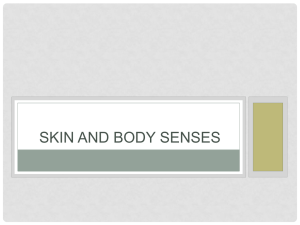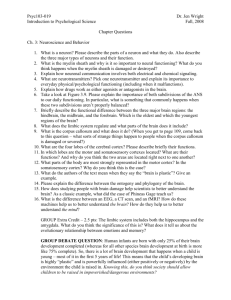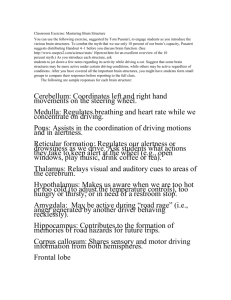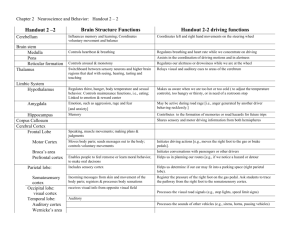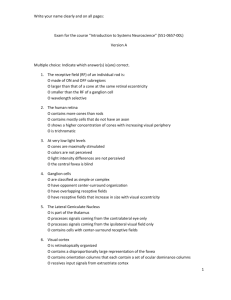Ch 14 Cutaneous Senses
advertisement
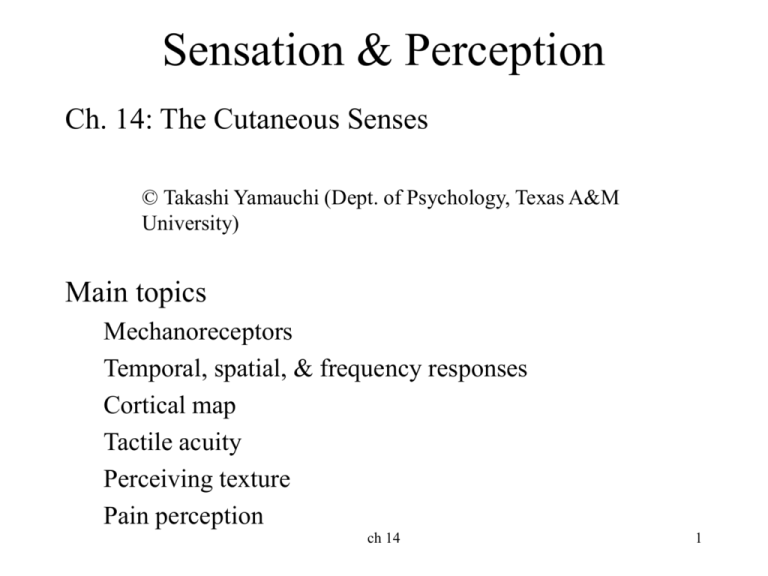
Sensation & Perception Ch. 14: The Cutaneous Senses © Takashi Yamauchi (Dept. of Psychology, Texas A&M University) Main topics Mechanoreceptors Temporal, spatial, & frequency responses Cortical map Tactile acuity Perceiving texture Pain perception ch 14 1 The Cutaneous sensations • Sensations based on the stimulation of receptors in the skin. – Pressure, vibration, heating, cooling, and tissue damage. • It is served by the somatosensory system. • It also creates – Proprioception (the body sense – e.g., balancing the body) – Kinesthesis (the sense of the position and movement) ch 14 2 • Ian Waterman (a 17 year old butcher) – Contracted flu. – Damaged somatosensory cortex – Couldn’t – As a result, he lost the ability to • feel skin sensation below his neck. • feel his body, • adjust his body position • grasp objects properly. ch 14 3 Skin • “monumental façade of the human body” – (Cornel, 1953) ch 14 4 2 Layers Skin Epidermis dermis Functions of Skin: Keeps the body warm Protects the body from bacteria Help maintains the integrity inside the body. ch 14 5 Mechanoreceptors: pick up the movement of skin Merkel receptor Meissner corpuscle Ruffin cylinder Pacinian corpuscle ch 14 6 Mechanoreceptors • Mechanoreceptors respond to – mechanical stimulation such as pressure, stretching, and vibration. • Transduction (Pacinian corpuscle) – When the corpuscle is bent relative to the axon, the tip of the nerve ending opens ion channels in the membrane. – The opening permits the entry of molecules with positive charge, which depolarize the membrane potential. – (from N. R. Carlson “Physiology of Behavior”, 7th ed) ch 14 7 ch 14 8 Fig. 14-1, p. 331 ch 14 9 Fig. 14-2, p. 332 Pathways from skin to cortex Skin spinal cord thalamus cortex • 2 pathways • Medial lemniscal pathway – Proprioception & touch perception • Spinothalamic pathway – Temperature and pain ch 14 10 Cortical map • Somatosensory cortex – Corresponds to body locations • Cortical magnification factor – Sensitive areas occupy large cortical areas (e.g., fingers) • These cortical areas are plastic (can be changed by experience) – e.g., trained pianists have larger cortical representations of fingers. ch 14 11 Perceiving details (tactile acuity) • Measuring tactile acuity – Two-point threshold minimum separation needed between two points to perceive them as two units – Grating acuity placing a grooved stimulus on the skin and asking the participant to indicate the orientation of the grating ch 14 12 • The density of Merkel receptors and tactile acuity is highly correlated. – The areas that have more Merkel receptors are more sensitive Merkel receptors ch 14 13 Perceiving vibration • The Pacianian corpuscle is responsible. – Sustained stimuluation no response – Rapid on-off stimulation response Merkel receptor Meissner corpuscle Ruffin cylinder Pacianian corpuscle ch 14 14 Perceiving texture • Temporal cues – The movement of a surface generates vibration, which gives the perception of texture (rough vs. fine texture) ch 14 15 Perceiving objects • Haptic perception – Perception, in which 3D objects are explored with the hand. – Involves sensory, motor, and cognitive systems. • Demonstration – – – – – Identifying objects The person sitting next to you close his / her eye. Pick up an object (e.g., an eraser) Let him / her touch the object and identify the object. Swap the role. ch 14 16 Perceiving Objects - continued • Psychophysical research shows that people can identify objects haptically in 1 to 2 sec • people use exploratory procedures (EPs) – Lateral motion – Pressure – Enclosure – Contour following ch 14 17 The Physiology of Tactile Object Perception - continued • Monkey’s somatosensory cortex also shows neurons that respond best to: – Grasping specific objects – Paying attention to the task • Neurons may respond to stimulation of the receptors, but attending to the task increases the response ch 14 18 Figure 14.19 Receptive fields of neurons in the monkey’s somatosensory cortex. (a) This neuron responds best when a horizontally oriented edge is presented to the monkey’s hand. (b) This neuron responds best when a stimulus moves across the fingertip from right to left. (From “Movement-Sensitive and Direction and Orientation Selective Cutaneous Receptive Fields in the Hand Area of the Postcentral Gyrus in Monkeys,” by L. Hyvarinen and A. Poranen, 1978, Journal of Physiology, 283,523-537, figure 3. Copyright © 1978 by ch 14 19 The Physiological Society, UK. Reprinted by permission.) Figure 14.20 The response of a neuron in a monkey’s parietal cortex that fires when the monkey grasps a ruler but that does not fire when the monkey grasps a cylinder. (From “Cortical Processing of Tactile Information in the First Somatosensory and Parietal ch 14and Y. Iwamura, 1978. In G. Gordon (Ed.), 20 Association Areas in the Monkey,” by H. Sakata Active Touch, p. 61. Copyright © 1978 by Pergamon Press, Ltd. Reprinted by permission.) Pain perception ch 14 21 Pain Perception • Pain comes from – a sensory component and an emotional component. • Three types of pain: – Nociceptive - signals impending damage to the skin • Types of nociceptors respond to heat, chemicals, severe pressure, and cold ch 14 22 Types of Pain – Inflammatory pain • caused by damage to tissues and joints that releases chemicals that activate nociceptors – Neuropathic pain • caused by damage to the central nervous system, such as: – Brain damage caused by stroke – Repetitive movements which cause conditions like carpal tunnel syndrome ch 14 23 Nociceptive (skin-oriented) Inflammatory (tissue & joints-oriented) Neuropathic (nervoussystem-oriented) ch 14 ways. See text for details. (Adapted from Scholz 24 Figure 14.22 Pain can be created in a number of different & Woolf, 2002.) Brain areas for pain perception – Subcortical areas • hypothalamus, limbic system, and the thalamus – Cortical areas • S1 and S2 in the somatosensory cortex, the insula, and the anterior cingulate cortex – the pain matrix ch 14 25 Figure 14.23 The perception of pain is accompanied by activation of a number of different areas of the brain, including the somatosensory cortex, thalamus, anterior cingulate cortex, amygdala, ch 14 26 hippocampus, and thalamus. The ring-like configuration formed by the anterior cingulate cortex, hippocampus and amygdala form the limbic system. What does this tell? • Cognitive control can modify pain – Interpreting stimuli (suggestion, recognition) – Shifting attention (think about something else) – Expectation (e.g., placebo effect fake medicine can be sometimes effective) ch 14 27 Cognitive and Experiential Aspects of Pain • Expectation - when surgical patients are told what to expect, they request less pain medication and leave the hospital earlier • Shifting attention - virtual reality technology has been used to keep patients’ attention on other stimuli than the pain-inducing stimulation ch 14 28 Cognitive and Experiential Aspects of Pain continued • Content of emotional distraction - participants could keep their hands in cold water longer when pictures they were shown were positive • Individual differences - some people report higher levels of pain than others in response to the same stimulus – This could be due to experience or to physiological differences ch 14 29 Figure 14.25: Participants kept their hands in cold water longer when looking at positive pictures than when looking at neutral or negative pictures. ch 14 30
